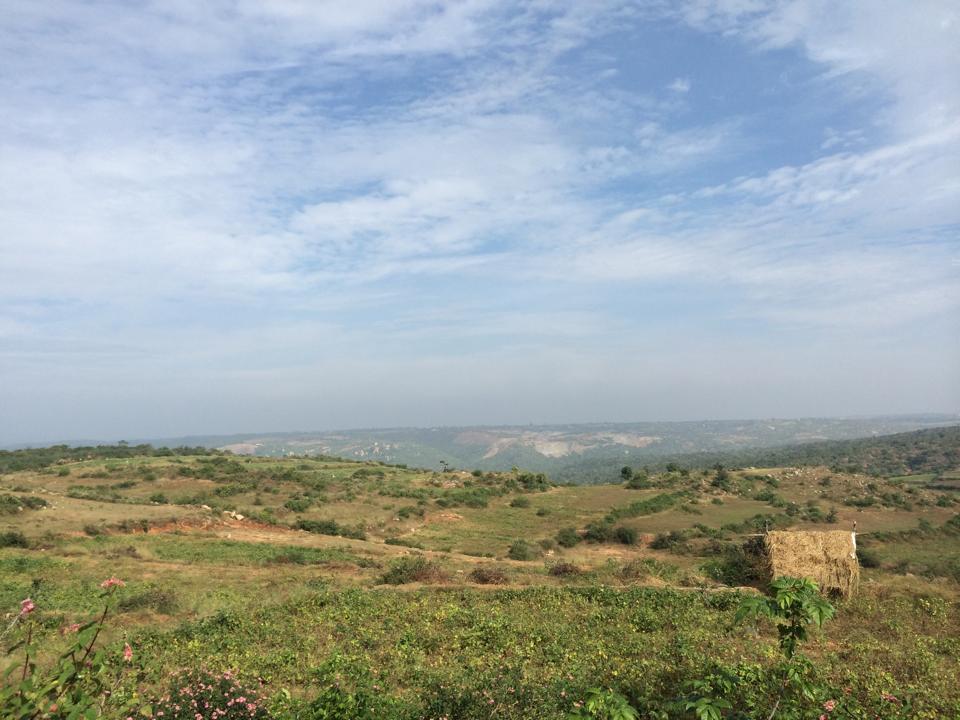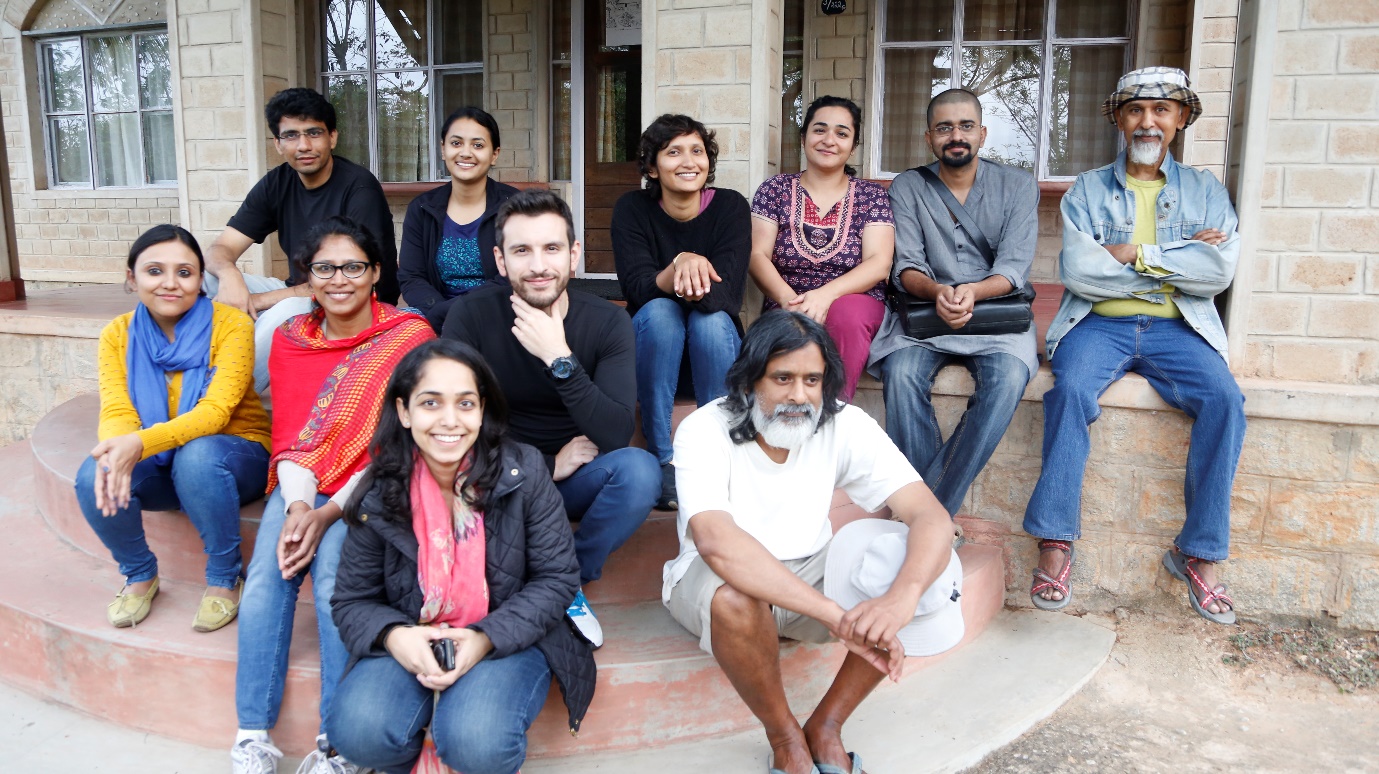Ecological restoration as an adaptation to climate variability: critical reflections from ASSAR’s South Asia Team visit to Navadarshanam
Ecological restoration as an adaptation to climate variability: critical reflections from ASSAR’s South Asia Team visit to Navadarshanam
written by Chandni Singh, Indian Institute for Human Settlements
The first thing that hits you when you enter Navadarshanam (nava=new, darshanam=vision), a rural initiative 50 km away from Bangalore, is the bewildering range of sounds. To our city-deafened ears, the calls of unfamiliar birds, mooing cows and chattering squirrels were the first signs of a healthy ecosystem.

A view of the Navadarshanam site. The land, once barren, has regenerated with minimal human interference.
Recognising that our research activities were intensifying and our team was expanding, ASSAR’s South Asia team members from the Indian Institute for Human Settlements (IIHS) went for a 2-day visit to Navadarshanam in December 2014. The trip aimed to i) allow the team to collectively reflect on the past few months of research and stakeholder engagement, ii) refine personal and team research roles going forward, and iii) explore ecological restoration and sustainable farming practices as a niche example of local adaptation. Since several team members were unable to attend an earlier trip to WOTR’s watershed development project site, the visit allowed us to understand how social ecological systems transition from barren to productive systems over large time scales and with sustained local action.
What is Navadarshanam?
Navadarshanam is a collective initiative of concerned people exploring and experimenting with a way of life that moves away from resource-intensive, urban living towards an understanding of coexistence and interdependence between and within social and ecological systems. Almost thirty years ago, the Navadarshanam site, spread over 115 acres, was a denuded landscape with no vegetation and a poor soil and water profile. The initial group of people in this collective fenced the land and left it fallow to allow it to regenerate. Over this multi-decadal timescale, the once barren land gradually transformed into a healthy functional social ecological system.
Today, Navadarshanam has expanded to supply organic products through a local farmers’ cooperative, serves as an example of ecologically conscious living, and provides training in sustainable farming practices. Currently, 22 rural households from the nearest village of Gaganahalli are engaged in farming, processing and selling organic products.

Navadarshanam’s vegetable farm, which is only 2% of the total land area and is grown using permaculture principles. “We want to only use what is necessary. The remaining land has trees; they help absorb water, attract birds, and provide an environment for the vegetables to grow well.”
The local context: climate-sensitive livelihoods
Gaganhalli is a village on the Karnataka-Tamil Nadu border with 48 households. Rainfed agriculture is the main livelihood in this semi-arid region and crops grown are ragi (finger millet) - which is the main food crop - as well as pulses, groundnut, and vegetables. However, Gopi, our key informant and long-time resident of Navadarshanam, discussed how livelihoods and lifestyles are changing in Gaganahalli. “There is no doubt that there has been a change in the climate. The immediate observation is the absence of patterns in rainfall, which makes farming risky. However, rural livelihoods also face several non-climatic threats from forest fires, crop loss by wandering elephant herds, unavailability of good quality seeds, and ever-increasing water scarcity.”
Finally, increasing urbanisation has introduced previously absent influences, which are changing the social fabric of such rural areas. The opening of an alcohol shop near the village has led to increased drinking and domestic abuse. Youngsters are increasingly seeing agriculture as a non-viable livelihood and prefer to move to urban centres for education and jobs. The highly localised example of Gaganahalli demonstrated to us how vulnerabilities are driven and enhanced by a complex interplay of climatic and non-climatic factors. Also, decisions to respond to them are highly embedded in the local socio-ecological context.
Ecologically-conscious farming and living as a possible adaptive trajectory
Drawing on learnings from larger ecological movements and the local communities’ cumulated experience of experimenting with soil and moisture conservation, rainwater harvesting, alternative energy sources, organic farming, and ecological restoration, Navadarshanam serves as an interesting case of local adaptation to increasing climate variability. Some of the methods they use are:
- Growing local varieties that are well-suited to dry conditions and saving and sharing seeds.
- Using SRI (System of Rice Intensification) to grow millets, which are hardy and nutritionally superior to cereals such as wheat or maize. Growing millets on a small plot and transplanting them after the monsoonal rain reduces the risk farmers have in case of failed/delayed rainy season.
- Growing plants in indents instead of on raised rows, which better retain moisture and nutrients.

Members of the local farmer cooperative at Navadarshanam
The role of local and rural-urban networks
Navadarshanam is intricately engaged with neighbouring villages. Through dialogue and example, they try to encourage locals not to sell their land and help in building practical skills of youngsters (for example, driving or labelling grain packets for sale). In addition to using produce grown on Navadarshanam’s land, the farmer cooperative does value-added processing for grains sourced from farmers outside the locale. The initiative also has direct links with its closest urban centre, Bangalore, through the steady supply of organic food and products to the city’s many organic food outlets. Apart from this, it has seeded other initiatives at an individual level, and thus served as a demonstration site. Finally, it also trains approximately one hundred people every year in its sustainable farming and living practices.
The limitations of scaling up
From our short visit, we felt Navadarshanam works. Through their experiments, they are helping build a locally relevant farming system that is cognizant of climatic risks, while simultaneously strengthening livelihoods by linking local farmers to an urban centre like Bangalore.
Discussing plans of scaling up or replicating such a model elsewhere, Gopi said, “Our aim has never been to expand or scale up. We personally interact with farmers to understand their needs and priorities and then experiment to find locally relevant solutions. It is this intimate relationship of trust that allows us to do what we do.” He believes that Navadarshanam has been effective and potentially inspiring because it is at the community-scale.
Navadarshanam’s trajectory also served as an example of a model of operation different from WOTR’s community-based watershed development. Being a niche initiative, over its thirty years, Navadarshanam has remained outside the purview of government processes because, in Gopi’s words, “engaging with the government involves too much talk and paperwork. Whenever we have interacted with them it has been time-consuming and very difficult because of the different worldviews we have.” Such observations made us wonder, can initiatives such as Navadarshanam function only outside the definite structures of government interventions or can policy encourage or provide the space for highly localised initiatives to develop?
Personal reflections and the way forward
The visit, though short, was, as one member noted, “a good way to refine personal trajectories within a large and interdisciplinary project such as ASSAR.” Others found the experience of visiting a successful adaptation intervention “helped ground theoretical concepts in practice.” One member also felt this was “an interesting example of an initiative taking seed and having multiplier effects on ecological and social systems several decades later.”
The trip served as a scoping visit to explore dynamics in the rural urban continuum around Bangalore, one of ASSAR’s transects in South Asia. It allowed us to understand how factors such as increasing climatic variability, human-animal conflicts or an existing policy thrust on input-centric farming, has repercussions on local livelihoods and response strategies. For the team, the visit allowed us to reflect on our work so far, invigorated some to engage with their research in a nuanced and grounded manner, and helped explore research synergies within the team and plan future activities.

A revitalised team! ASSAR South Asia team members with Gopi and Nagaranjan from Navadarshanam